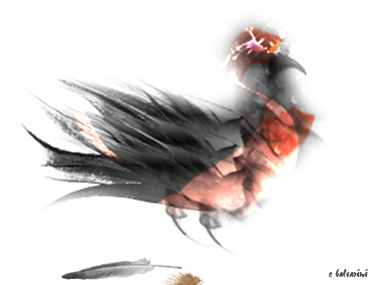CAT AMONGST THE PIGEONS (2

Posted by Jeremy Eccles | 04.07.12
Sadly, the cat never escaped!
Last Saturday's promising discussions at the Sydney Opera House - Aboriginal Art: it’s a white thing and Write the truth, or shut up – turned out to be damp squibs in terms of achieving any conclusions. Many words were spoken, but, after agreeing that there was “very little strong writing” about Aboriginal art, the second session proceeded to ignore the key issue of criticism and journalism entirely!
The first session was more successful in sticking to the topic – Richard Bell's otiose Theorem that, amazingly, is still being discussed ten years down the track. I suppose this is because the urban artists behind the idea that all remote Aboriginal art is merely 'tourist art' produced by the Ooga Boogas of “a dying, soon dead culture” have as yet failed to prevail in a world where interest in the beauty and hidden meanings inside the vibrant 'abstract' canvases and barks from Northern Australia remains so strong.
Despite referee Vernon As Kee's assertion that this work is just ethnographic and 'primitivism', you only have to Google 'Aboriginal art' + 'Seattle' to see the enthusiasm with which the display of the Kaplan/Levi collection at the Seattle Art Museum is being greeted.
With a couple of academics on the panel as well as Bell and Ah Kee – Ian McLean and Rex Butler – we had an awful lot of clever ideas about post-Aboriginality, secular Aboriginality, and whether Aboriginal art curators in major institutions were in fact “a white thing” - but no one really wanted to tackle the elephant in the room, despite the echoes still hanging about in the SOH Playhouse from Gary Foley's mea culpa there in January (qv).
And that elephant was whether art by Aborigines like Bell and Ah Kee is actually 'Aboriginal art' in the same way that Emily Kngwarreye's work is Aboriginal art. For it seems that as long as their strong, political works derived from their lives and their Western art training are called 'Aboriginal art', Vernon Ah Kee will continue to complain: “By attaching these kind of ideas of the noble savage, or the exotic, or the primitive to our identity, it’s kind of like we have to anchor ourselves in the past, in the stone age in fact, when we don’t live our lives like that. We live contemporary and technological and sophisticated lives”. And Richard Bell will go on saying, “I don't think I make Aboriginal art – but when I'm shown in a museum, I'm ghettoised by that title”.
Ah Kee, dissatisfied with the 12 new Indigenous galleries at the National Gallery, fancied a museum of his own – but was never asked which Aboriginal art would be allowed into it. He did opine that just a “small corner” would be left for White art - “all about the Cronulla riots”, apparently because current museums reflect just such a distorted view of the two different 'Aboriginal arts'.
Of mild interest was the discovery that Bell's Theorem emerged not just to justify the appropriation obvious in his painting, Scientia E Metaphysica, but because he'd been thrust into an earlier exhibition with Imants Tillers and Emily Kngwarreye, and was keen to make a stand against Tillers' frequent appropriation of Aboriginal art. Strangely, it seems he wasn't worried about any cruel comparisons between his work and the originality of Kngwarreye's.
A moment that might have changed things came when McLean plucked up the courage to suggest, “I don't think Aboriginal art is a white thing” - but that was too hot a potato to examine closely. What a pity, because McLean is also the editor of the recent Power Publications book, 'How Aborigines Invented the Idea of Contemporary art' – which is jam-packed with a mighty range of 'strong writing' on the subject and would have given the generous audience for last weekend's talk-fest a very complete view of the history of the reception of 'Aboriginal art' by writers ranging from Peter Sutton to Vernon Ah Kee. The basic conceit in the title is a bit of post-Modern games playing, but the ringing endorsement of 'Aboriginal art' in the Kngwarreye sense by McLean at the end makes excellent sense:
“In the 1980s Papunya Tula revealed to the artworld something about itself that had not been brought into focus by Western contemporary art: Aborigines initiated in tribal lore could also make contemporary art. This lesson, that difference was the opportunity for something more, is also the first prerequisite of globalism. (So) Australian Aborigines were amongst the first to show what contemporary art after modernism felt like. In doing this, they played a decisive role in the artworld's globalisation at the end of the twentieth century”.
Share this:
»  del.icio.us
»
del.icio.us
»  Digg it
»
Digg it
»  reddit
»
reddit
»  Google
»
Google
»  StumbleUpon
»
StumbleUpon
»  Technorati
»
Technorati
»  Facebook
Facebook
Contact Details
Further Research
Artists: Emily Kngwarreye | Imants Tillers | Richard Bell | Vernon Ah Kee
News Tags: Bell's Theorem | Gary Foley | Sydney Opera House
News Categories: Blog | Conference | Event | Feature | Industry | News
Exhibition Archive
- 10.10.17 | TARNANTHI 2017
- 11.08.17 | Natsiaas 2017
- 20.07.17 | APY ART DOMINATES THE WYNNE
- 17.07.17 | Anangu Artist Wins $100,000 Prize
- 14.07.17 | The End of AAMU
- 11.07.17 | ART ACROSS THE COUNTRY
- 11.07.17 | TARNANTHI IN OCTOBER
- 05.07.17 | TJUNGUṈUTJA - from having come together
- 13.06.17 | Ghost-Nets Straddle the World
- 07.06.17 | Grayson Perry Going Indigenous?
- 05.06.17 | Barks Bigger than Ben Hur
- 27.05.17 | NGA QUINQUENNIAL 2017
- 21.05.17 | Blak Douglas Finds Home at the NGA
- 21.05.17 | BRIAN ROBINSON WINS HAZELHURST WOP
- 18.05.17 | PARRTJIMA 2.0
Advertising

